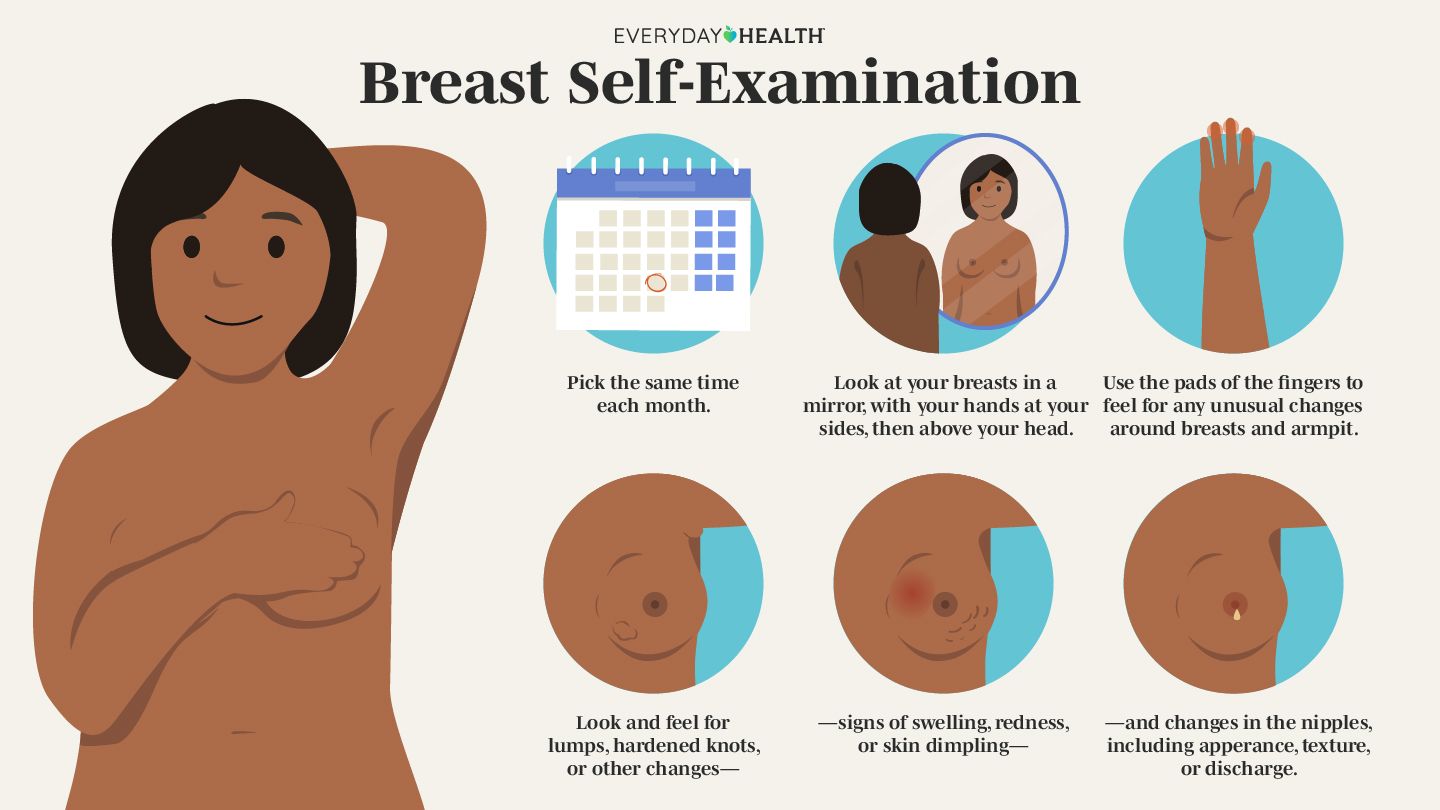Regular self-breast exams are crucial for breast health; however, they should complement, not substitute, professional breast exams and screening procedures such as mammograms and breast ultrasound scans. It remains essential to schedule regular appointments with your primary care provider or gynecologist to ensure thorough breast cancer screenings.
Conducting a breast self-exam at home aids in identifying potential breast changes, enabling you to consult with a healthcare provider. Consistent self-breast exams play a crucial role in preserving breast health and detecting cancer at an early, more treatable stage. While many changes may not be cancerous, it’s important to communicate any observed alterations to your healthcare provider.
Table of Content
1. Introduction
2. What is Breast Self-examination.
3. When to carryout Breast Self-examination.
4. Approaches to conducting a breast Self-examination at home.
5. Duration for an appropriate Breast Self-examination.
6. Challenges involved with performing a Breast Self-examination.
7. Outcome and follow-up.
Imagine a platform where you can be paid a whooping 2,200 just for watching one video. are you looking for a place where you can grow your business, and earn income – all within a supportive and vibrant community. Look no further than Veritas Global, the revolutionary social network designed to empower personal and professional success.
Introduction
What is a breast self-exam?
A breast self-exam is a systematic approach for examining your breasts, involving both visual inspection and tactile examination. Regularly observing and feeling your breasts enhances your ability to identify changes or variations. While mammograms are widely considered the primary tool for detecting breast abnormalities, a self-exam at home is recommended by many healthcare providers as it fosters familiarity with your own breast health.
Is it necessary to do a breast self-exam?
Engaging in monthly breast self-exams is instrumental in detecting changes that could indicate infection, breast disease, or breast cancer. The key objective is to establish a baseline of what is normal for you. Being familiar with the typical appearance and feel of your breasts enables you to recognize any deviations or changes that might occur.
The important of breast Self-examination cannot be over emphasized, I remember one certain time around last year a woman came to a diagnostic where I was working at the moment for a ultrasound scan of the breasts, she had a visible lump on one of her breast. It happened that she has been palpating this lump on her breast( around the nipple) for a while now,she has been using trado-medical treatment thinking its a “boil” not until it became kind of severe she came to the hospital….well she didn’t think it was something to be taken seriously according to her…The sonographer placed the probe on the affected breast and guess what? We saw multiple Malignant masses on the affected breast….she had to proceed to do a mammogram scan …… And she later……This story tells the important of breast Self-examination, assuming she was aquatinted with the typical appearance of her breast she would have taken the appropriate step on time and the mass would have been taken care of on time before it became malignant.
How often should I perform a breast self-exam?
Most healthcare associations advise conducting a breast self-exam on a monthly basis. While it’s not a foolproof method for detecting breast cancer, it remains a valuable routine for maintaining breast health at home. Research indicates that many individuals diagnosed with breast cancer first noticed a lump through self-examination. Recognizing what’s normal for your breasts empowers you to promptly notify a healthcare provider upon detecting any changes.
Is there a particular time of the month I should do breast self-exams?
- For individuals still menstruating with a regular period, it’s recommended to perform a breast self-exam after their period ends. This timing helps reduce the impact of hormonal fluctuations on breast tissue and provides a more consistent baseline for self-examination.
- For individuals who have reached menopause or experience very irregular periods, it’s advisable to select a specific day each month for their breast self-exam. Opt for a consistent and memorable day, such as the first day of the month, the last day of the month, or a favorite number, to establish a routine for regular examination. Keep a journal of your findings or make a note in your smartphone of what you see and feel.
Different approaches to conducting a breast exam at home involve:
- standing in front of a mirror without a shirt and bra. With arms down, check for alterations in breast shape, swelling, skin dimpling, or changes in nipple position. Raise your arms overhead and repeat the observation. Place hands on hips, flex chest muscles, and scrutinize for similar changes, ensuring a thorough assessment of both breasts.
- For a standing manual breast self-exam, initiate by removing your shirt and bra. Use your right hand to examine the left breast and vice versa. Apply gentle, moderate, and firm pressure with the pads of your three middle fingers, examining for lumps, thick areas, or variations. Follow a circular pattern, encompassing all areas, including the tissue near the armpit. Inspect under the areola and gently squeeze the nipple for any discharge. Repeat on the other side, with many finding it convenient to perform in the shower.
- In a lying down manual breast self-exam, optimize the spread of breast tissue by placing a pillow under your right shoulder. With your right arm behind your head, use your left hand for the examination. Apply the same technique with the pads of your middle fingers, pressing all regions of your breast tissue and under your armpit. Change the pillow and repeat on the other side, making sure to check under the areola and gently squeeze the nipple for any discharge—especially beneficial for individuals with larger breasts.
Remember that your breast tissue extends beyond the visible breast area, encompassing your armpit, collarbone, and the top of your abdomen. It’s important to recognize that breast tissue goes beyond the traditional focus on breast cleavage and nipples during self-exams.

How long does a breast self- examination take?
A breast self-exam is quick and can be seamlessly integrated into your daily routine. You can do it:
- While undressing at night.
- While dressing for the day.
- lying in bed at day break or at bedtime, or during your shower.
- Incorporating these moments into your daily schedule makes it convenient to prioritize your breast health.
What are the challenges with doing a breast self-exam?
While self-exams are valuable for fostering awareness of the normal characteristics of your breasts, there are some associated risks. Some of the risks of breast Self-examination include:
- One risk associated with self-exams is the misconception that they can substitute clinical breast exams by healthcare providers or mammograms. A breast self-exam serves as a valuable at-home tool for self-awareness, but it doesn’t replace the comprehensive assessments provided by medical professionals. It’s crucial to understand that regular screenings and consultations with healthcare providers remain essential for thorough breast health care.
- Anxiety can arise from the concern of detecting a lump or abnormality during a self-exam. While most lumps are noncancerous, the fear of finding a cancerous lump can lead to unnecessary anxiety or worry. It’s important to approach self-exams with awareness and seek professional guidance to address any concerns, alleviating unnecessary stress.
Outcome and Follow-Up
Which types of lumps are commonly considered normal when palpating your breasts?
It’s common to have lumps in your breast tissue, and it doesn’t necessarily warrant panic. Certain individuals naturally have lumpier breast tissue. Developing an awareness of what is normal for you can assist in recognizing when something deviates from the usual.
When is the appropriate time to contact my healthcare provider?
Reach out to a healthcare professional if you observe:
- The presence of a lump or any alteration in the texture of your breast tissue.
- Unusual or bloody secretion from your nipple.
- Skin dimpling, redness, or swelling.
- Alterations in the orientation of your nipple, such as inward turning.
Consider that factors like menstruation can influence the appearance and sensation of your breasts. Consulting with a healthcare provider for a breast exam can help determine if diagnostic tests such as ultrasound or mammogram are advisable.
What signs should one be vigilant for in relation to breast cancer?
A self-breast examination is not a diagnostic method for breast cancer; only a qualified healthcare professional can confirm the potential harm of a self-detected lump. Familiarizing yourself with breast cancer signs can be beneficial.some of the signs include:
- Inverted nipples.
- Dimpling of your breasts
- Redness, soreness, rash and swelling on your breasts.
- Irregular nipple discharge.
What is the reason behind the shift in not recommending breast exams anymore?
Healthcare providers don’t discourage self-exams because they don’t recommend them. Instead, they acknowledge that self-exams may not be the most effective method for detecting or screening breast cancer. Nevertheless, many providers advise becoming acquainted with your breasts through home exams, as it is the optimal way to understand your normal and promptly report any changes to your healthcare provider.
Does a self-breast examination surpass the effectiveness of a mammogram?
A self-breast examination is not a replacement for a mammogram or a healthcare provider’s breast exam. It serves as an at-home tool to complement annual mammograms and clinical breast exams performed by your provider, rather than substituting for a mammogram, which remains the primary method for detecting breast cancer.
Incorporating a monthly self-exam into your routine, such as during bedtime or showering, contributes to maintaining breast health and identifying early signs of disease. Regular self-exams enhance your familiarity with your body, enabling you to better recognize and discuss any changes with your healthcare provider.
Risk
Engaging in a breast self-examination to enhance breast awareness is a secure method to acquaint yourself with the typical appearance and texture of your breasts.
Nevertheless, there are certain constraints and potential risks, including:
- Discovering a lump can lead to anxiety. While the majority of breast changes or lumps in women are non-cancerous, encountering something suspicious in your breast can evoke concern about its implications. The period until you can consult your doctor may involve several days of apprehension.
- Further examinations and processes might be required to investigate identified lumps or alterations. If you come across a dubious lump, additional tests like a diagnostic mammogram or breast ultrasound, or a biopsy to extract breast tissue for analysis, may be necessary. If the lump proves to be noncancerous (benign), you may perceive the invasive procedure as unnecessary.
- Exaggerating the benefits of self-exams is common. A self-breast exam should not be considered a replacement for a clinical breast exam conducted by your doctor or a screening mammogram. While becoming more familiar with the normal appearance and texture of your breasts can complement breast cancer screening, it is not a substitute for these medical procedures.
Ultimately, integrating regular breast self-examinations into your routine is a proactive measure for breast health. Keep in mind that knowledge is empowerment, and by becoming acquainted with your own body, you empower yourself to detect any changes early. If you ever have concerns, don’t hesitate to consult your healthcare professional. Let’s prioritize our well-being and encourage those around us to do the same. Together, we can take control of our health and build a future where breast health is a priority for everyone. Stay vigilant, stay informed, and take care of yourself!
 Skip to content
Skip to content 
